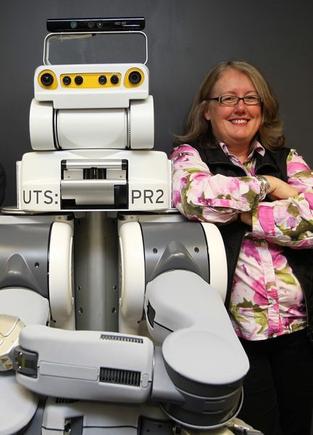Why marketers should take note of social robots
- 04 July, 2017 16:26

UTS robotics professor, Mary-Anne Williams, is urging big brands to consider using ‘social robots’ as part of their strategic marketing mix as companies look to intensify and deepen customer engagement and experience.
Williams is a leading roboticist and director of the UTS ‘Magic Lab’, which is focusing on the disruptive nature of intelligent socially aware technologies.
“Social robots can improve the customer experience and that can be across all industries from retail to health to education and travel. It is all about the customer experience, and a robot can give you a very one-on-one highly customised physical interaction,” she told CMO.
UTS recently qualified for the 2017 RoboCup Home Social Robot League, a competition that requires teams to design robot behaviours that allow for interaction and collaboration with people in realistic home situations.

Team ‘UTS Unleashed!’ will represent Australian research and innovation in social robotics at RoboCup in Japan with support from the NSW Government’s Research Attraction and Acceleration Program.
The team will design and develop complex artificial intelligence (AI) software that will enable a robot to communicate with humans, navigate and map new environments, sense and recognise objects and faces, and perform adaptive behaviours in different human-centric situations.
The humanoid is Pepper, a human-shaped robot from industry partner, Softbank Robotics, which can be programmed to analyse and respond to human expression and voice.
Speaking with CMO about its many uses, Williams said ‘social robotics’ will likely attract marketers because the technology powerfully addresses both customer engagement and experience.
“Here’s a technology that can enhance that dramatically in a novel and innovative way," she said. "When it comes to technology and marketing, social robots are at the top of the tree. There really is nothing better.”
Robot fever
So what exactly is a social robot? Williams said a social robot is different to an ordinary factory robot.
“Factory robots complete tasks that might be welding a door on a car. It is a very specific kind of task. A social robot has two extra kinds of capabilities. One is emotional intelligence. It has some stealth awareness and it has awareness of other people around. It knows that people are not objects and that people have intention. They have agency.”
The other capability, she explained, is social intelligence, which is about collaboration and cooperation.
“The robot understands that it can help people, it can add value to people’s lives. And the robot also knows that people could help it. So if it can’t open a door, or open a jar, or perform some other task, it then can ask for help. And then people can help it get over those rough things.”
Williams said social robots are not just automated problem solvers, they have emotional and social intelligence that allows them to collaborate with people in safe, fluent and enjoyable ways to enhance the human experience.
The Commonwealth Bank, for example, is already using social robots. While Williams couldn’t divulge exact details, she acknowledged it is a “huge partnership” with UTS.
“It is unbelievably exciting that the Commonwealth Bank has a social robot,” she said, adding UTS is also working with Stocklands, which has shopping centres and retirement homes.
“We are working with a number of other CBA customers, all looking to explore social robotics. The reason is social robots are a disruptive technology. They will touch every industry over the next few years. And companies who understand that it is all about innovation and competitive advantage want to explore this technology to find out how it is going to impact them. So we’re working with the Commonwealth Bank to help them understand the impact.”
But while brands are starting to adopt the technology, Williams suggested there’s still a slow uptake in Australia. “It is not necessarily in Australia, but certainly in Japan, it is going nuts. In Japan, you find them in restaurants. You’ll also find them in aged care facilities, and in people's homes, similarly in Korea," she continued.
“And we’re beginning to see them in places in the US. They are beginning to show up in large shopping centres. They are stocking shelves in companies there. There are intelligent shopping trolleys. There are robots in shopping malls that help you find your way, or help you find the shop that you are looking for.”
Additionally, Williams explained how a driverless vehicle, an autonomous vehicle, is a social robot - or will be. It can also be a goldmine for marketers, she noted.
“The vehicle will need to know that there are humans in the car. The car will need to know whether they are happy, if they want to listen to music. The car will also need to know what other cars are around it and who is in those cars, potentially," she said. "Who is in the other cars determines how the other cars are being driven. Are they in a hurry? Do they need to let them go in front because they are actually taking someone to the hospital in an emergency?
“These are all social elements and I think a big opportunity for marketing as well because a social vehicle will know when is the right time to show the passengers whatever they are marketing, whether it’s clothing or maybe a new dental technique - whatever it is. If you can show, or present, your marketing material at the time when the person is most receptive, you can be so much more effective. It is not just hit and miss. It is not just trial and error. It is very crafted and targeted.”
Follow CMO on Twitter: @CMOAustralia, take part in the CMO conversation on LinkedIn: CMO ANZ, join us on Facebook: https://www.facebook.com/CMOAustralia, or check us out on Google+:google.com/+CmoAu

